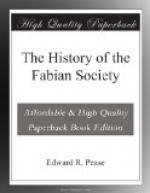How much of personality, how little of principle there was in the great controversy is indicated by the fact that Mrs. Bernard Shaw signed the Special Committee Report, with the reservation that she also completely agreed with the Reply. Mr. Headlam also was a party to both documents: Mr. G.R.S. Taylor, alone of the three Executive members of the Special Committee, supported the Report and dissociated himself from the Reply. Of course the Executive Committee had to decide points in their Report by a majority. That majority, in the case of the proposed revision of the Basis, was, as already mentioned, one vote only. I did not concur with the view expressed about the Labour Party, a body scarcely less easy to be understood by an outsider than the Fabian Society itself: and at that time I was the only insider on the Fabian Executive.
But the real issue was a personal one. The Executive Committee at that time consisted, in addition to the three just named, of Percy Alden (Liberal M.P. for Tottenham), Hubert Bland, Cecil E. Chesterton, Dr. F. Lawson Dodd, F.W. Galton, S.G. Hobson, H.W. Macrosty, W. Stephen Sanders, Bernard Shaw, George Standring, Sidney Webb and myself. Mr. Alden was too busy with his new parliamentary duties to take much part in the affair. All the rest, except of course Mr. Taylor, stood together on the real issue—Was the Society to be controlled by those who had made it or was it to be handed over to Mr. Wells? We knew by this time that he was a masterful person, very fond of his own way, very uncertain what that way was, and quite unaware whither it necessarily led. In any position except that of leader Mr. Wells was invaluable, as long as he kept it! As leader we felt he would be impossible, and if he had won the fight he would have justly claimed a mandate to manage the Society on the lines he had laid down. As Bernard Shaw led for the Executive, the controversy was really narrowed into Wells versus Shaw.
The Report was sent to the members with “Fabian News” for December, 1906, and it was the occasion of much excitement. The Society had grown enormously during the year. The names of no less than ninety applicants for membership are printed in that month’s issue alone. In March, 1907, the membership was 1267, an increase of nearly 500 in two years.
The discussion was carried on at a series of meetings held at Essex Hall, Strand, under the chairmanship of Mr. H. Bond Holding, on December 7th and 14th, 1906, and January 11th and 18th, February 1st and March 8th, and also at the Annual Meeting for 1905-6, held on February 22nd, 1907. The series was interrupted for the London County Council Election on March 2nd, in which many of the members were concerned.




